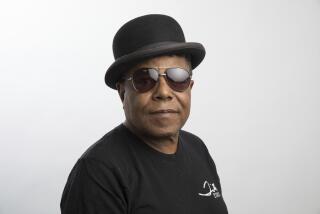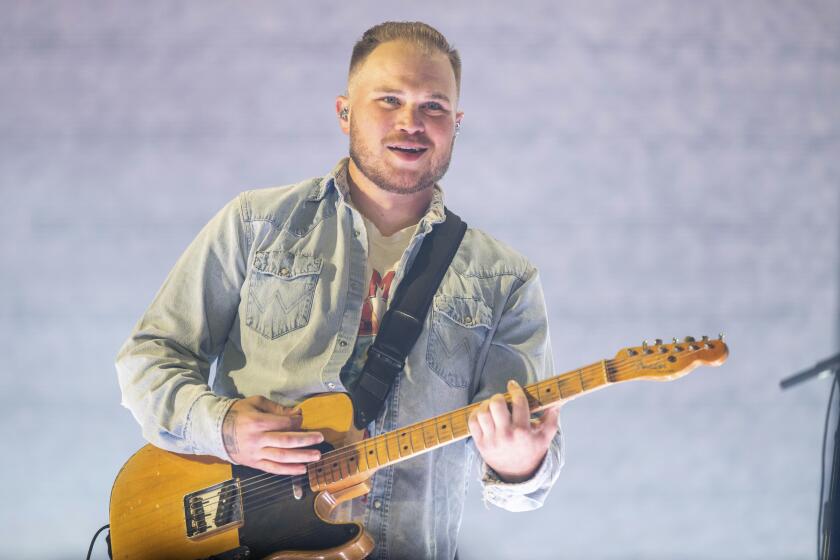In step with flamenco’s past
Both of Son de la Frontera’s CDs open with the most basic human percussion: stamping feet and clapping hands. Then a guitar comes in, blending with a Cuban tres, and finally a voice that sounds like the Spanish equivalent of an old blues singer.
For a young band, widely hailed as the cutting edge of flamenco nuevo and applauded for creating a fusion with Latin American styles, the surprising thing about Son de la Frontera is how starkly traditional it sounds.
“Our music is muy flamenca,” tres player Raul Rodriguez agrees, speaking Spanish from his home in Seville shortly before heading to the U.S. for performances that included a stop Thursday in L.A. at Echoplex. “With some small touches of other styles but always within the limits of the tradition. It is a reflection of the style of Moron, a recognition of the climate there in the last century, the music of the elders.”
Moron de la Frontera is a small town in the heartland of Andalusia, and the group’s four other members grew up in its thriving flamenco scene. Guitarist Paco de Amparo and dancer Pepe Torres are great-nephews of the celebrated guitarist Diego del Gastor, and the first album they made after forming the band with Moi de Moron, Rodriguez and percussionist Manuel Flores -- “Son de la Frontera” in 2004 -- was a tribute to Gastor’s work and the local style.
“It is a very important town in the history of flamenco,” Rodriguez explains, “with a sound that is very personal, very emotional and very distinct. It is hard to describe, because this music is complex, it’s very beautiful, and the emotion sometimes doesn’t give you time to think -- just being able to feel it, that’s enough.”
Rodriguez grew up in Seville’s blues-rock scene but began visiting Moron and studying flamenco in the early 1990s. Meanwhile, the first wave of older Cuban soneros was visiting Spain, and he was intrigued by the connections between the styles. Compay Segundo, shortly to become famous with the Buena Vista Social Club, performed in Andalusia and toured with Rodriguez’s mother, singer Martirio, and when she went to Havana she brought back a tres, the eight-stringed Cuban guitar.
“Adding the tres was a way of reclaiming the traditional relationship between Andalusia and Cuba,” Rodriguez says. “It was a sort of pilgrimage, to investigate that history. Seville, Cadiz and Havana were the main points of contact between Spain and the Americas, and that interchange went on for hundreds of years. So it is not so much a fusion; this was already within flamenco, and we are just bringing it out.”
Flamenco is intensely Spanish and particularly connected to the Spanish Gypsies, but it is also one of the great global fusion styles. A product of indigenous traditions, Gypsy migrations and the centuries when Andalusia was a cultural mecca of the Islamic world, it combines rhythms and techniques from Europe, Asia and Africa. So it has naturally been receptive to other influences, including Latin American styles and rock.
When the conversation turns to ethnicity, Rodriguez notes Son de la Frontera’s own blend: “Pepe, Paco and Manuel are Gypsies. And then Moi and I are not. And, of course, there are differences. The sound of every culture is different, and one should not lose sight of that, because differences are creative. It is not something bad, or something to fight against; it is what makes the music so rich.”
Many young flamenco groups have pursued that idea in other ways, blending the music with blues, jazz and hip-hop. Asked why Son de la Frontera has not made similar experiments, Rodriguez says that at first it was simply a matter of taste.
“But there is something more,” he adds. “Maybe it is important that ours is that last generation that had a chance to experience the way things were done in the past. You could say we are the last analog generation, and the next generation is already digital.
“Many traditions are at risk of disappearing -- not only music but language, cooking, a whole way of life. In Moron, they still experience flamenco in the traditional climate, at small parties in people’s homes, but we don’t know how long it will be that way. And since we grew up with that, but also know the digital way, maybe we can transmit this to the next generation in a way they can understand.”
The idea, he says, is not to be locked into a tradition but to appreciate that tradition.
“Flamenco is something that must be respected,” Rodriguez says. “That is the only way you can introduce new elements into a style that has been around for centuries. You have to study it with great respect and treasure it like something sacred. It’s like entering holy ground; you must do it with humility, with tranquillity and with fidelity to the music.”
--
Son de la Frontera
Where: Echoplex, 1154 Glendale Blvd., Los Angeles
When: 8 p.m. Thursday Feb. 28,
Price: $25 to $35
Contact: (213) 413-8200
More to Read
The biggest entertainment stories
Get our big stories about Hollywood, film, television, music, arts, culture and more right in your inbox as soon as they publish.
You may occasionally receive promotional content from the Los Angeles Times.










